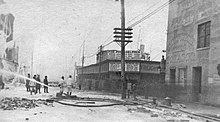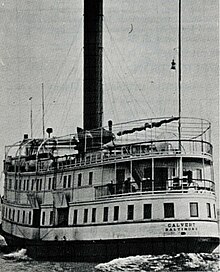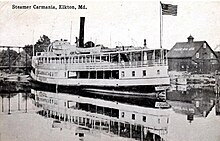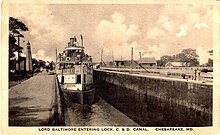
The Type C4-class ship were the largest cargo ships built by the United States Maritime Commission (MARCOM) during World War II. The design was originally developed for the American-Hawaiian Lines in 1941, but in late 1941 the plans were taken over by the MARCOM.
SS William Rawle was a Liberty ship built in the United States during World War II. She was named after William Rawle, an American lawyer in Philadelphia. Rawle was appointed as United States district attorney in Pennsylvania, in 1791. He was a founder and first president of the Historical Society of Pennsylvania, president of the Pennsylvania Abolition Society, and for 40 years a trustee of the University of Pennsylvania.
SSMary was a Design 1022 cargo ship built for the United States Shipping Board immediately after World War I.
Mississippi Shipping Company of New Orleans, Louisiana was a passenger and cargo steamship company founded in 1919. In 1961 officially changed its name to the Delta Line. The Mississippi Shipping Co. serviced port from the Gulf of Mexico and east coast of South America. The Mississippi Shipping Co. was formed to support coffee merchants and Brazilian produce to New Orleans and up the Mississippi River. competing with the New York City trade. Delta Line failed to upgrade to container ships and modernize as other shipping lines did in the 1970s. In 1982, Delta Line, now owned by the Holiday Inn Corporation sold the line to Crowley Maritime. Crowley was the largest US barge and tugboat operator at the time. Crowley started to modernize the ships on the route, but sold the shipping line to the United States Lines in 1985. United States Lines brought some of the ships into its routes but went bankrupt in 1986. At its peak in 1949, the Mississippi-Delta line owned 14 ships with a total of 98,000 gross register tonnage. Delta Line also moved into passenger cruise with to ship. During World War II the Mississippi Shipping Company was active with charter shipping with the Maritime Commission and War Shipping Administration. During wartime, the Mississippi Shipping Company operated Victory ships, Liberty ships, and a few Empire ships.
Pacific Far East Line, also called PFEL in short, was a passenger and cargo shipping line founded in 1943 by Thomas E. Cuffe, in San Francisco, California. At the beginning he started by chartering foreign ships to run the lines in tramp trade. Later scheduled cargo services were added to the line. During World War II the South Atlantic steamship line was active with charter shipping with the Maritime Commission and War Shipping Administration.

Agwilines Inc was a passenger and cargo shipping company of New York City. Agwilines is short for Atlantic, Gulf & West Indies Steamship Inc. AGWI Lines group operated four main lines in the 1910s, 1920s and 1930s:

Calmar Steamship Company was a proprietary subsidiary of the Bethlehem Steel founded in New York City in 1927. Bethlehem Steel Company founded Calmar Steamship Company and other steamship companies after finding general shipping companies could not meet the company's needs in a timely manner. At the time Bethlehem Steel Company was the second-largest steelmaker in the United States and the world, only behind U.S. Steel. Calmar Steamship Company shipped Bethlehem Steel Company products from the Atlantic coast to the Pacific coast. On the return trip, Calmar Steamship Company would bring lumber products from the Pacific coast to the Atlantic coast. Calmar Steamship Company closed in 1976, as United States steel manufacture declined in the 1960s.
Northland Transportation Company operated cargo and passenger ships from Seattle to Southeast Alaska starting in 1923. During World War II Northland Transportation Company was active in charter shipping with the Maritime Commission and War Shipping Administration. Northland Transportation Company, proposed a loan from United States Shipping Board to build a ship for Puget Sound-Alaska trade in 1933. In 1934, the company was granted a $350,000 loan to build a new ship. The 1,400 tons passenger ship, was built at Lake Washington Shipyard in Houghton, Washington. Northland Transportation Company Seattle dock and warehouse were at Pier 56, now Ainsworth and Dunn Wharf.

Sudden & Christenson Company was a shipping and lumber company founded in 1899. Edwin A. Christenson and Charles Sudden of San Francisco, California started the company and shipping line to supply northwest lumber to cities on the east coast, west coast and far east. The ships would return with goods and passengers from the remote ports. Some of the ships also had passenger service on the upper decks. Sudden & Christenson Company and Los Angeles Steamship Company-United American Line started a joint venture called the Arrow Line in 1926. Arrow Line operated from Northwest Pacific Coast Ports and Argentina, Brazil and Uruguay. Sudden & Christenson's San Francisco Headquarters was at 110 Market Street with docks at Pier 15. Sudden & Christenson Company was incorporated in California in 1903. The Sudden & Christenson company dissolved in 1944 and Sudden & Christenson, Inc was founded to pay of the liability of franchise taxes, and operated till dissolved in 1965. Charles Sudden died in 1913 and Edwin Christenson became president with D. Walter Rasor as vice president. The company started with schooners and added steamships. During World War I Sudden & Christenson operated Merchant navy ships for the United States Shipping Board. During World War II Sudden & Christenson was active with charter shipping with the Maritime Commission and War Shipping Administration. Sudden & Christenson had docks in San Francisco, Vancouver, Seattle, Portland, Astoria, Los Angeles and Yokohama, Kobe, Shanghai, Dalian and Tsingtao. Far East ports were a joint venture with the North China Line. In late 1950s came the more cost-effective loading and unloading system, container shipping. The Sudden & Christenson fleet, now aged and on an obsolete system, put the company in decline, closing in 1965.
American Foreign Steamship Corporation was founded in Brooklyn, New York City, in 1932 by Ira L. Rosenson, Sophia Pruss and Elias Katz. Rosenson was an attorney and the major shareholder in the firm. American Foreign Steamship Corporation purchased a 5,570-ton cargo ship SS Eastern Glen from the American South African Line in 1933. American Foreign Steamship Corporation named the ship the SS American Oriole. The ship was built by Kabushiki Kaisha Uchida Zosengo company of Yokohama, Japan, in 1920. The ship was a United States Shipping Board ship. The next two ships purchased was the SS Liberty Glo and SS Wildwood, these were Hog Islanders type ships. The two ships were purchased from the South Atlantic Steamship Company. In 1938 another Hog Islanders ship was purchased the, SS Magmeric, renamed the SS American Robin. The American Oriole was sold to England in 1940 to help with the World War II efforts. She was renamed the SS Barberrys, but on November 26, 1942, she was sunk by a torpedoed from German submarine U-663 off of St. John's, Newfoundland.

Wilmore Steamship Company was a steamship shipping company that was founded in New York City in 1930. The Wilmore Steamship Company mainly operated coal ships, called Collier ship. The coal ships main routes were loading coal at Hampton Roads, Virginia, and delivering the coal to New England ports. The first two ships on the route were the SS Berwindglen and SS Berwindvale. Both ships were built by Bethlehem Steel's Bethlehem Shipbuilding Corporation at Quincy, Massachusetts, at the Fore River Shipyard. SS Berwindglen and SS Berwindvale were new 4,411-ton colliers ships, that had first United States engines that used pulverized coal-fired boilers. The steamship SS Mercer, a 9,500 ton merchant ship was the test ship of pulverized coal, modified to evaluated pulverized coal in 1929. The test were good and the SS Berwindglen and SS Berwindvale were built for this new fuel. Wilmore Steamship Company was named after Wilmore Heights, Pennsylvania. Wilmore Steamship Company was active in supporting the World War II effort.
Overlakes Freight Corporation was shipping agent company founded in New York City on April 21, 1932, by William M. Nicholson. Overlakes Freight Corporation operated Liberty Ships during and for post World War II efforts. Most of Overlakes Freight Corporation ships were purchased by the War Shipping Administration for the war. Nicholson also owned the Nicholson Universal Steamship Company, Nicholson, Erie, Dover, Ferry Line, Nicholson Terminal & Dock Company, Aqua Terminal & Dock Corporation and the Nicholson Transit Company.
Prudential Steamship Corporation was a shipping company founded in 1933 in New York City by Stephan Stephanidis. Prudential Steamship Corporation operated the Prudential Lines. Prudential Lines main routes was from the United States to Mediterranean ports. The Prudential Lines was never successful and was always near bankruptcy. Prudential Lines was active in supporting the World War II efforts. At its peak in the 1960s Prudential Lines owned and operated two tankers, and five cargo ships. In 1960 the Prudential Steamship Corporation was sold to Spyros Skouras and his family. In 1969 the Prudential Lines merged with Grace Lines, which continued to operate the fleet as the Prudential Grace Line.
Sword Line Inc. was a steamship company founded by Charilaos "Charles" G. Poulacos and Abbott Abercrombie in New York City in 1933. Sword Line Inc. had shipping routes from Atlantic ports to and Gulf of Mexico ports. Charilaos "Charles" G. Poulacos and Abbott Abercrombie purchased the ship Eastern Sword in 1932. The Eastern Sword was a 3,785-ton cargo ship built in 1920 at the Uraga Dry Dock Co. Ltd, at Uraga, Japan. The ship sank after being hit by a torpedo from German submarine U-162 on May 4, 1942 twelve miles (19 km) off the coast of Georgetown, Guyana. The Eastern Sword had a crew of 38 and only 13 survived the attack. Sword Line Inc. was active in supporting the World War II effort.
M & J Tracy Inc. was a shipping and tugboat towing company founded in New York City by the racy brothers in 1881, as M & J Tracy Transportation company. The brothers: John Tracy, Michael J. Tracy and Thomas Tracy founded the Tracy Towing Line in 1917. The brother's sisters: Catherine Tracy and Helen Tracy were on the company's board. M & J Tracy Inc. office was located at 1 Broadway in New York City and had a field office in Brooklyn. The Tracy companies owned both owned tugboats and barges. Early work was transporting coal to New York Harbor port in barges. M & J Tracy Inc. supported the World War II effort by operating United States tugboats and ships. After the war, M & J Tracy Inc. purchased some surplus ships. M & J Tracy Inc. also operated the M & J Tracy New York Harbor Industrial site. The family lived in the Frank J. Helmle 1912 Tracy Mansion at 105 8th Avenue, Brooklyn, New York, now a 7 unit Condo. John Tracy founded the Maritime Association of the Port of New York. John Tracy was born in 1855 and died on October 1, 1931. Michael J, Tracy died on November 7, 1927,













